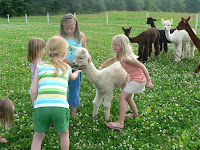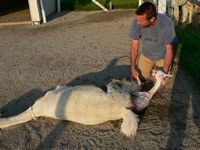
Crystal Light is her name, and this is her story.
On the morning of April 8, 2010, Chenoa looked to be quite uncomfortable. Her due date was near, so I figured the cria must have been laying in a position that was uncomfortable for her.
After a little while of careful watching, I made the decision to contact our local veterinarian. We discussed the possibility of Chenoa having a uterine torsion, which means that her uterus is twisted, thus blocking the birth canal.
Upon the arrival of the vet, he determined that Chenoa indeed had a uterine torsion. In our nine years of raising alpacas, this was my first experience with a uterine torsion. What ensued sounds comical, but was absolutely necessary to save Crystal's life.
Chenoa was tranquilized and laid on her side. The vet determines which direction the uterus is twisted, so as to know which way to roll the body of the alpaca. He ties a rope to her back legs, has me firmly hold downward on the belly of the alpaca, and he rolls her over (picture legs straight up in the air as she goes over :). He checks again, and determines we've rolled her the wrong way. So, following the same procedure, we roll her back (back to square one). Then we slowly, roll her the other direction. Ahhh, success.
The vet tells me that the cria's nose is right there and that the delivery will happen within an hour or so. Oh, how slowly time passes...
One hour, no delivery. Two hours, still no delivery. I administered a shot of Oxytocin to assist Chenoa's body in re-initiating the contractions. This appeared to work, as the delivery started shortly after.
Oh no, another complication. This time a minor one, but given what had already happened, my adrenaline level was at an all time high. Crystal's head was tilted downward, making it unable to pass through the opening. So, the OB gloves go on, lubed up and in I go to manipulate the head, pushing back slightly, so as not to injure the neck, and bringing the nose forward. Another success...the delivery progresses.
One final albeit minor issue. Poor Chenoa has been in labor for such a long time that she's just about out of strength, so she stops pushing. Thankfully, the head, neck and front legs have all been delivered, so I give assistance by gently pulling on the cria with each contraction. One contraction...two contractions and Crystal is delivered.

Praise the Lord for the successful delivery of TCS Crystal Light!
Stay tuned next week for the story of Crystal Light - The Friendliest Alpaca.

















